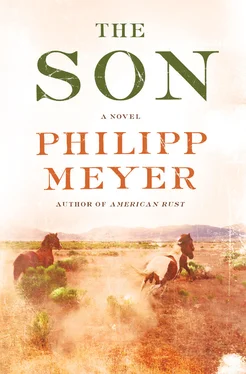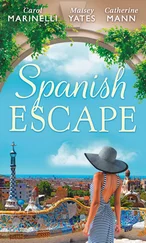The youngest one shook his head. “ Yee, ” he said, “ Tiehteti tsa? awinu .”
“What do you think?” I said.
“ Aitu, ” said the oldest. “Very poor. We will be tracking her all day.”
The others sighed.
We snuck down to the river and looked for turtles to catch, made a few snares, and when the boys decided the doe had calmed down and likely begun to stiffen from her wound, we followed her through featureless tall grass to where she was bedded a half mile away, using four spots of blood and a scuffed patch of moss on a log. She took off running but was hit with three more arrows. We sat awhile longer and when we found her again she was dead.
I said: “That seemed like cheating, using the call to bring her in.”
“So next time get closer and use a lance.”
“Or a knife.”
“Or go after a bear.”
“I was only saying about the fawn call.”
The oldest one waved his hand impatiently. “We were told to bring a deer back, Tiehteti, and they’d be mad if we didn’t get one. And next time you might try to break the neck so we don’t have to track the deer all day.”
“It would also be fine to hit one of the big arteries.”
“You’re rolling your fingers,” said the eight-year-old. He drew an imaginary bow. “You have to pop them away from the string.”
“Like we showed you,” said the oldest.
I didn’t say anything.
“If you roll your string, you will never shoot straight.”
“Toshaway will tell you I’m a good shot with a gun.”
“So go find us a sapling, Mr. Good Shot.”
THE BOYS MADE their own bows and arrows, but the people who made the real weapons were the old men, retired warriors who had become too blind or too slow to go on raids, or maybe their wind had given out, or maybe, unbelievably to us, they had grown tired of killing and wanted to spend their last years making items of an artistic nature.
Osage was preferred for the bows — though ash, mulberry, or hickory could substitute — and dogwood for the arrows. We carried the big ohapuupi seeds with us, planting them anywhere they might grow, and as this had been done by the various tribes for hundreds or maybe thousands of years, bois d’arc trees were found all along the plains. Equally important was the par ua, or dogwood. When we found a grove of them we would prune back the trunks almost to the ground. The next spring each trunk would send out dozens of thin new shoots, which grew very straight and were easy to make into good arrows. The location of these arrow groves was kept track of, and they were harvested carefully, making sure that the trees would survive.
A regular bow — better than any factory could make today — was worth one horse. The upper and lower limbs had to release with even pressure while pulling a specific weight at a specific distance from the grip. A fancy or unusually good bow was worth two or three horses. They were all about a yard in length (short compared to the eastern tribes’, as, unlike them, we fought from horseback) and backed with the spine sinews from a deer or buffalo. If times were bad, the bowyers would turn out bows very quickly; if times were good — if our warriors were not being killed and their equipment not being lost on raids — the bowyers would take their time and their bows would be the stuff of legend.
Arrows were no different. It could take half a day to make one just right: straight, the proper length and stiffness, the feathers all in alignment — though in a single minute of fighting you might need two dozen. The shafts were felt and squeezed and held up to the light and straightened in the teeth. A crooked arrow was no different from a bent rifle barrel. The Comanches expected their bows to reach fifty yards when they were shooting quickly, hundreds of yards if they were taking their time. On a calm day I saw Toshaway kill an antelope at a full furlong, the first shot going over the animal’s back (though falling so quietly it was not noticed) the second falling just short, also in silence, and the third finally telling between the ribs.
The strings were commonly sinew, which when dry shot arrows the fastest but could not be depended on when wet. Some preferred horsehair, which shot slower but was reliable in all conditions, and still others preferred bear gut.
The best feathers for fletching were turkey feathers, but owl or buzzard feathers were also fine. Hawk or eagle feathers were never used as they were damaged by blood. The best shafts were grooved along their length. We used two grooves and the Lipan used four. This prevented the arrow from stanching the wound it had just cut, but it also kept the shaft from warping.
The blades of hunting arrows were fixed vertically, as the ribs of game animals are vertical to the earth. The blades of war arrows were fixed parallel to the earth, the same as human ribs. Hunting points were made without barbs and tied tightly to the shaft so they could be pulled from an animal and reused. War arrows had barbs and the blades were tied loosely, so that if the arrow was pulled, the head would remain lodged in the enemy’s body. If you were shot with a war arrow, it had to be pushed through the other side to be removed. By then all the white people knew that, though they did not know that we used different arrows for hunting.
All the plains tribes used arrows with three feathers, though some of the eastern bands used only two, which we looked down on, as they were not accurate. Of course the eastern Indians did not care much, as they lived on a weekly meat allowance from the white man and were drunk most of the time anyway, wishing they had died with their ancestors.
OCCASIONALLY, THROUGHOUT THE fall and winter, I would see the German girl who’d been taken captive with me. Most families had at least one slave or captive, often a young Mexican boy or girl, as Mexico was where they did most of their raiding and horse stealing — the Comanches’ toll on that country was on another scale, entire villages wiped out in a single night — Texans had nothing to complain about.
Of course there were numerous white captives as well, from settlements near Dallas, Austin, and San Antonio; there was a boy who had been snatched in far East Texas; there were captives from other tribes. But as I was considered to have a great future, I avoided talking to them.
The only one I broke this rule for was the German girl, whose name was Suhi?ohapit u, Yellow Hair Between the Legs, but who was mostly referred to as Yellow Hair. Whatever she had been to her family, to the Comanches she was invisible, a nonperson. She spent all her time scraping skins, hauling wood and water, digging tutupip u, everything I had done my first six months. But for her, there would be no end.
In spring, I ran into her in one of the pastures, looking after the horses. She looked well fed, though her muscles were ropy for a white woman and she didn’t have much fat. She appeared to have grown water shy. I could smell her from a good distance and her back was dotted with mohto?a as if she had not bathed in months.
“It’s you,” she said in English. “The chosen one.”
I could tell she was sulking.
“I see they’re treating you well.”
It threw me off to hear English. I told her — in Comanche — that she might consider washing herself. Which was not fair, but I was mad at her for saying I ought to be read out as some kind of deserter.
“Why should I?” she said. “I hoped it would make them stop touching me, but it hasn’t.”
“They aren’t supposed to do that anymore. They could get in big trouble.”
“Well, they are.”
“Well, they’re not supposed to.”
“That’s very useful of you to say.”
Читать дальше












